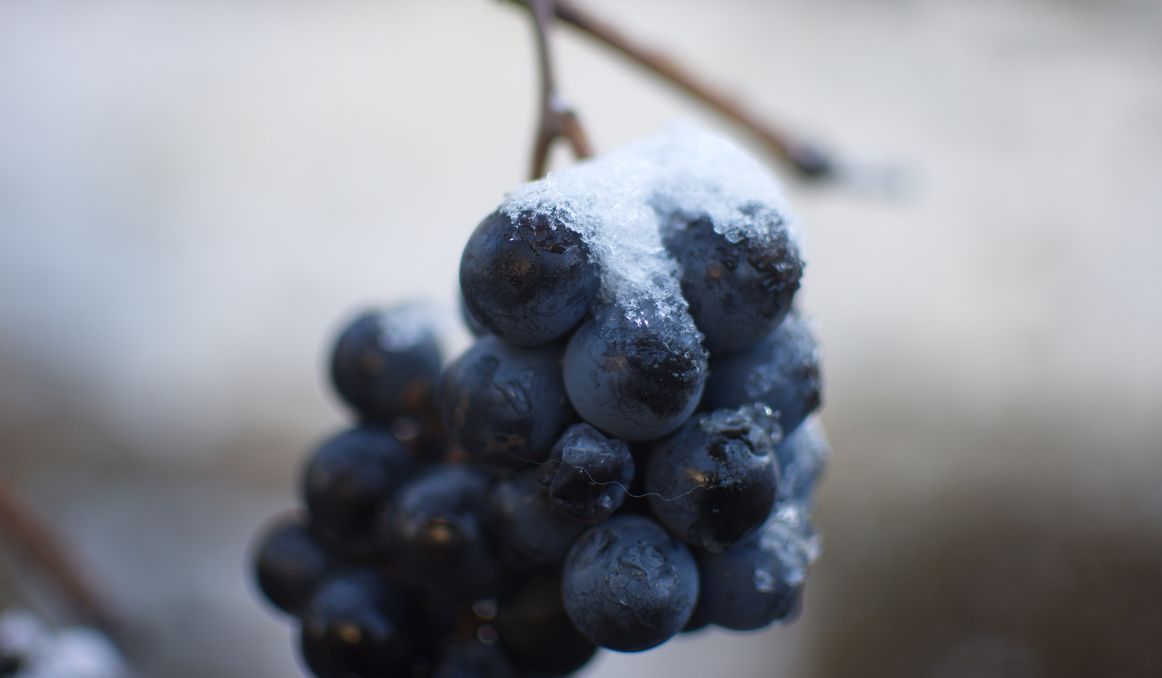What Is an “Ice Wine”?
If you’ve been exploring the territory of wines, you may have heard about the recent uproar over ice wine out of Canada. A few wineries have been receiving accolades and awards for this interesting take on wine that seems to have stemmed from a happy accident a couple hundred years ago.
Perhaps at first you shrugged it off, thinking that people are putting ice in their wine (gross), or that vintners are simply serving their ice chilled (sometimes).
But now you’re digging deeper. After all. Why would those small changes win awards?
Ice Wine

Ice wine, also called icewine, is actually a rare and delicate sweet wine that was indeed the result of an accident. Or, better said, the solution to mistake or miscalculation.
You see, in the year 1794, German farmers had waited too long to harvest their grapes, and an early frost got to the entire crop, potentially damaging otherwise quality produce.
Instead of scrapping the entire batch of grapes, the farmers rushed the fruit to production and hurried to make what wine they could.
The result was a delicious, super sweet, syrupy wine that has come to be known as a delicacy in the wine world.
Today, icewine can only be called such, ice wine or icewine, if it is prepared in exactly the same way as that accident.
The grapes must be left on the vine past fall harvest and allowed to endure first frost.
The next morning, the grapes must be harvested, hand picked, still frozen on the vine, and pressed into must immediately.
What happens is that only 20% of each grape is actually used for the must, most of the water is frozen and will not release a liquid. Instead, vintners extract a thick, gold liquid from each grape that is high in sugars.
As such, icewine is sweeter than most wines you will find, and naturally so.
Further, the fermentation process of icewine is slower and longer, allowing yeast to convert at a more languid rate, which preserves much of the sugar and ends with an alcohol concentration much lower than most wines, usually around 10%, and sometimes as low as 6% ABV.
The Risks of Producing Ice Wine
Ice wine production is not for everyone, and for good reason.
There are risks inherent to making this delicate dessert wine. The potential that the grapes will simply rot on the vine before first frost is ever present, and then there is the chance that you will not get to the grapes quickly enough.
Harvesters must be ready to drop everything and rush out to handpick the grapes on a moment’s notice. If not caught in time, the grapes will thaw, and the effect of pressing naturally frozen grapes will have been lost.
Why Ice Wine is so Expensive
All of this speaks to what makes icewine so expensive. Typically a bottle of ice wine, which is often half the size of a normal bottle of wine, will cost $30 on average, and it can run much higher.
Icewine involves a truly delicate process that requires 4 to 5 times the number of grapes to make as an average bottle of wine, as only 20% of each grape is able to be used.
It is also a much more labor-intensive process, demanding the human touch at every point of production.
Furthermore, while most wines are done fermenting in just a couple of weeks, ice wine takes several months to fully ferment, and it is usually not ready to serve for at least 10 months.
Those costs of course must be passed on to the consumer or it would not be worth the risk and investment for the vintner.

There do exist knock offs, of course. Plenty of wine producers attempt to mimic icewine by artificially freezing the grapes or even cryofreezing grapes and then pressing them for their sweeter juices.
And there is no doubt you can find excellent “iced wines,” but there is simply nothing like the real thing, which has been agreed upon by the wine industry at large.
For this reason, wine producers can only call their wine ice wine or icewine if it has been produced exactly as originally produced, with grapes naturally frozen on the vine after the first frost.
Every other version of an ice wine must call itself something else, so if you are looking for true icewine, be sure to read the label carefully.
How to Drink Ice Wine
Fortunately, ice wine is not generally an everyday wine. It is meant to be served for special occasions, as an indulgence, and as an after dinner treat for small gatherings.
Traditionally, icewine is meant to be served chilled as either an aperitif, a dessert wine to go with a less sweet dessert like cheesecake, on its own, or alongside mild, soft cheeses.
Be sure to keep it chilled for several hours before serving, and you’ll want to serve it in small glasses in small amounts. A little goes a long way.
Ice Wine Producers
While there is some evidence that Ancient Rome dabbled in the production of icewine, the real origins of the ice wine we know today are of course in Germany, which is the second largest producer of ice wine in the world and the largest producer in Europe.
The vast majority of excellent, award winning ice wine comes from Canada.
And in a distant third place come Japan and China, who of course have different winters to be mindful of in terms of awaiting first frost.
In the end, ice wine is really something you will have to experiment with yourself, perhaps, as a grower and vintner, set aside a small patch of land to allow grapes to linger longer on the vine for first frost, and see how the process goes for you.
In the meantime, it can’t hurt to head out and taste what other ice wine makers are coming up with.
Cheers!
Passionate about the wine and/or beer making process? So are we! If you’re interested in finding out how you can use our technology to control fermentation and monitor your yeast, save work hours and improve the cost-efficiency of your business, drop us a line at [email protected] or check out our product pages:
- Oculyze BB 2.0 (Better Brewing) Yeast Cell Counter App + Hardware
- Oculyze FW (Fermentation Wine) Yeast Cell Counter App + Hardware
Also, you can now get access to a fully functional demo account to test your yeast via our Web App. Completely free of charge and with no commitment to purchase.
Sources:


